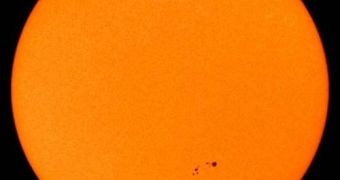Over the past year, astronomers have been concerned with the decreased levels of activity recorded by our Sun, which, if past cycles are any indicator, should be teeming with activity at this time. Very few sunspots and solar flares appeared earlier this year, but the scientific community sighed in relief over the 4th-of-July weekend, as modest sunspots appeared on the surface of the star, creating low-intensity solar flares. Despite the fact that the formations weren't what they used to be in other cycles, they hint at the fact that the Sun is slowly picking up the pace of its activities.
According to some observers, this weekend's emissions were the largest recorded in two years, which is saying something about the star, considering that, for 77 percent of the time in 2009, the Sun has been completely free of sunspots. These structures are areas of the surface where temperatures drop as compared with other regions around them, and also where a powerful magnetic field is created. Because of the lower temperature and higher densities, the spots prevent matter swarming below from reaching the surface, acting like a cap. When the matter underneath finally breaches it, it launches into space at large speeds, and causes solar flares, Space reports.
At the same time that this material is hurled into the surrounding space, streams of charged particles known as coronal mass ejections are also emitted, which travel at very high speeds away from a star. In our case, they can easily reach our planet, and, on account of their charge, can easily disrupt satellite communications in orbit, and endanger the life of astronauts on the International Space Station. When large ejections occur, the streams of particles can even travel through the magnetosphere – the protective magnetic layer that surrounds our planet – and affect power grids, transformers, and other structures related to electricity production or transport.
American agencies have estimated that a full magnetic storm coming in from the Sun could cause more than $2 trillion worth of damage in the United States alone at this point, mostly to the infrastructure. With lights and basic, electricity-powered commodities gone, civil unrest is a distinct possibility, and a report states that it would take between four to ten years to completely recover from the damage inflicted by large emissions. However, they are necessary in order to ensure that the Sun is healthy.
For instance, previous estimates said that 2013 would be the year of a maximum solar activity, which would exceed other peaks in intensity. Now, those estimates are being revised, and 2013 is expected to see a medium-intensity peak.

 14 DAY TRIAL //
14 DAY TRIAL //